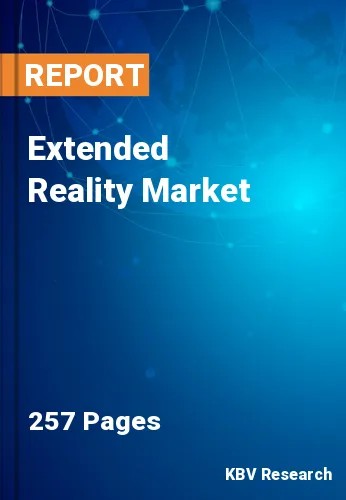The Global Extended Reality Market size is expected to reach $161.6 billion by 2028, rising at a market growth of 29.7% CAGR during the forecast period.
Extended reality or XR is a term to refer to Virtual reality (VR) and augmented reality (AR). This technology enables the integration or mirroring of the real world by generating a "digital twin world" with which the user can converse. VR and AR are expanding quickly and are being used in various industries, including entertainment, real estate, training, marketing, and remote work.
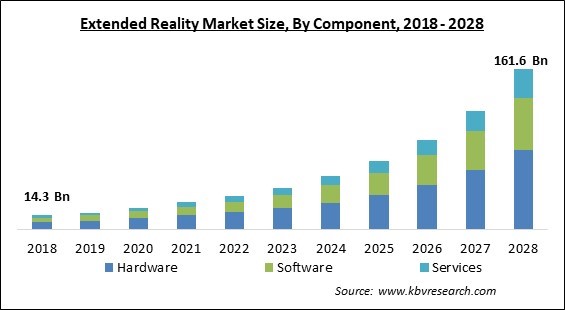
Extended reality (XR) that incorporates multiple senses, including touch, taste, smell, and sight, is known as multisensory extended reality. In the same way, hearing is mediated by pressure waves, odor molecules convey the smell, and light striking the eye's retina mediates vision. Multisensory extended reality sensory stimuli can be seen, heard, smelled, touched, and experienced in the surroundings.
Since the olfactory system in biology is interwoven through the sensory nerve system, scent plays a significant role in multisensory extended reality. Neuromorphic engineering, positive psychology, neuroenhancement, cognitive science, and nanoemulsion technology are all applied to multisensory experiences. It is a type of digital treatment for limbic system technology. By utilizing them as mood-enhancing technology, multisensory experiences can be tailored to improve user well-being through digital therapies, resulting in favorable changes in mood, cognition, perception, and behavior.
Extended reality with multiple senses makes use of OpenXR and WebXR technologies. Its components include auditory processing, visual systems, head-eye systems, multimodal integration, motor control, and perception. It is HCI technology or human-computer interface. Retinal reverse engineering is necessary for each of these.
The pandemic increased the demand for extended reality gadgets due to the unexpected condition of lockdowns in crucial places. Because of the COVID-19 pandemic, many companies allowed their workforce to work remotely, which increased the demand for online conferences, training, and meetings. The key actors were also required to work together to develop and implement various fresh, flexible strategies to improve the customers' experiences. Additionally, the need for online education grew due to the closure of schools, colleges, and other educational institutions owing to the pandemic. Such demands provided the AR and VR sectors with attractive potential. In addition, extended reality began to be used in new healthcare applications like telehealth, point-of-care, and home-based care. Therefore, the pandemic had a favorable impact on the extended reality market.
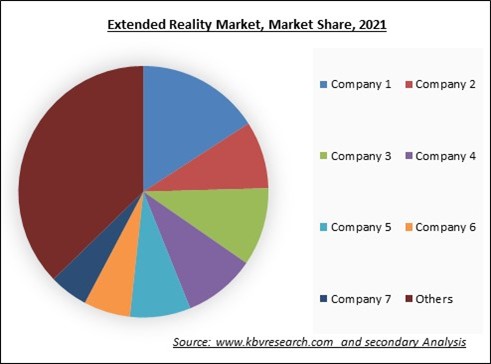
The leading players in the market are competing with diverse innovative offerings to remain competitive in the market. The below illustration shows the percentage of revenue shared by some of the leading companies in the market. The leading players of the market are adopting various strategies in order to cater demand coming from the different industries. The key developmental strategies in the market are Partnerships & Collaborations.
Extended reality (XR) has generated much interest in recent years. Major business organizations are currently making investments in virtual and augmented reality technologies along with mixed reality technologies. Many businesses are exploring numerous XR use cases, with many of them being used in immersive learning, R&D, entertainment, and remote help. Additionally, a number of sectors use immersive technologies to help customers try before they buy. The user can use these technologies to check the fit of the product. Additionally, such factors will boost the development of the extended reality market.
The pandemic also prompted governments to implement regulations meant to enhance how they communicate with citizens, raising the standard of public services. Many governments have begun implementing augmented reality (AR) technologies to handle the most complex demands of people in a post-pandemic scenario. In addition, exactly like AR, virtual reality has had a significant impact on government services. Virtual reality has evolved into an essential part of assistance for firefighting and social service groups since it has enhanced accessibility for many people. Therefore, in the coming years, the rising government support for the use of such technologies will bolster the growth of the market.
While XR is emerging as a helping technology in the healthcare sector, in recent years, it has been that extended reality gadgets too much use has negative health effects as well. Although extremely advanced, extended reality technologies have also been scrutinized for potential health risks. The most frequent risk is users getting hurt when they accidentally encounter real items immersed in the virtual environment. After using XR equipment, some users have reportedly experienced headaches, dizziness, eye strain, and nausea. Therefore, these factors have significantly slowed down the growth of the market.
Based on component, the extended reality market is categorized into hardware, software, and services. The hardware segment garnered the highest revenue share in the extended reality market in 2021. The hardware employed in XR technology, which may be accomplished without the use of any external devices, is one of its noteworthy qualities. From a hardware standpoint, heads-up displays (HUD) with early iterations of artificial intelligence or AI have prompted businesses to test out technologies that draw on the potential of AR and VR. For example, AR can advance consumer interactions by "overlaying" digital objects and information "on top" of real-world settings.
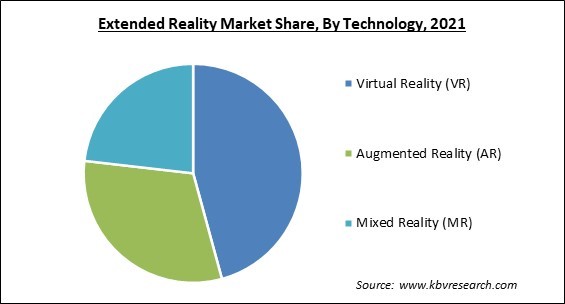
On the basis of technology, the extended reality market is divided into virtual reality (VR), augmented reality (AR) and mixed reality (MR). The augmented reality segment recorded a significant revenue share in the extended reality market in 2021. Wearable technology with lots of sensors is used to give augmented reality. Personalized marketing material delivery to consumers via sensors to a device like a smartphone may be as simple as internet search information or text notifications given through a wearable gadget. The ability of AR technology to move with the person through a device or provide content in a manner that frees the user's hands for other tasks is a crucial component that drives the expansion of the segment.
Based on end user, the extended reality market is segmented into gaming, retail, healthcare, manufacturing & industrial, media & entertainment, education, aerospace & defense, and others. The gaming segment witnessed the maximum revenue share in the extended reality market in 2021. Games now allow players to thoroughly invest themselves in their characters, making them considerably more participatory. In order to deliver a virtual environment that augments the user's physical experience, developers are utilizing AR and VR technology to provide realistic pictures as well as sound and many other sensory capabilities.
| Report Attribute | Details |
|---|---|
| Market size value in 2021 | USD 27.6 Billion |
| Market size forecast in 2028 | USD 161.6 Billion |
| Base Year | 2021 |
| Historical Period | 2018 to 2020 |
| Forecast Period | 2022 to 2028 |
| Revenue Growth Rate | CAGR of 29.7% from 2022 to 2028 |
| Number of Pages | 257 |
| Number of Table | 403 |
| Report coverage | Market Trends, Revenue Estimation and Forecast, Segmentation Analysis, Regional and Country Breakdown, Market Share Analysis, Competitive Landscape, Companies Strategic Developments, Company Profiling |
| Segments covered | Component, Technology, End User, Region |
| Country scope | US, Canada, Mexico, Germany, UK, France, Russia, Spain, Italy, China, Japan, India, South Korea, Singapore, Malaysia, Brazil, Argentina, UAE, Saudi Arabia, South Africa, Nigeria |
| Growth Drivers |
|
| Restraints |
|
On the basis of region, the extended reality market is analyzed across North America, Europe, Asia Pacific, and LAMEA. The North America segment recorded the highest revenue share in the extended reality market in 2021. The extended reality technologies have grown in this region as a consequence of the increased availability and use of connected devices like smartphones. Additionally, XR is widely employed in the manufacturing and retail processes. Major players who offer cutting-edge solutions are also situated in North America.
Free Valuable Insights: Global Extended Reality Market size to reach USD 161.6 Billion by 2028
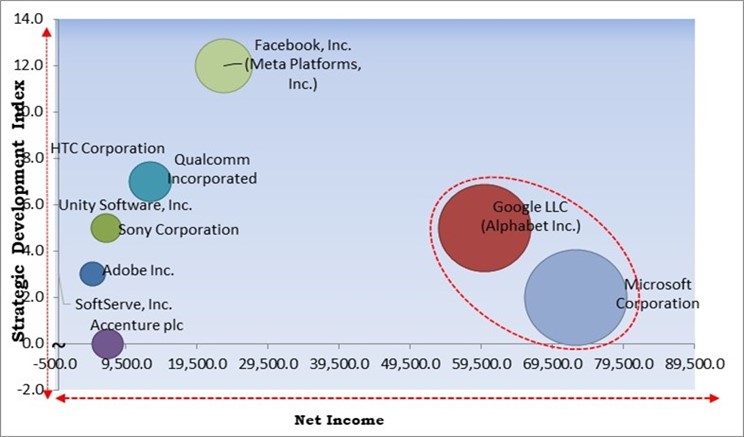
The major strategies followed by the market participants are Partnerships. Based on the Analysis presented in the Cardinal matrix; Microsoft Corporation and Google LLC (Alphabet Inc.) are the forerunners in the Extended Reality Market. Companies such as Facebook, Inc. (Meta Platforms, Inc.), Qualcomm Incorporated, Sony Corporation are some of the key innovators in Extended Reality Market.
The market research report covers the analysis of key stake holders of the market. Key companies profiled in the report include Meta Platforms, Inc. (Facebook), Sony Corporation, Microsoft Corporation, Google LLC (Alphabet Inc.), Accenture PLC, Qualcomm Incorporated (Qualcomm Technologies, Inc.), HTC Corporation, Unity Software, Inc., Adobe, Inc., and SoftServe, Inc.
By Component
By Technology
By End User
By Geography
The global Extended Reality Market size is expected to reach $161.6 billion by 2028.
Increased spending on augmented and virtual reality technologies are driving the market in coming years, however, The adverse impact of excessive use of XR technology and the impact of COVID on the manufacturing sector restraints the growth of the market.
Meta Platforms, Inc. (Facebook), Sony Corporation, Microsoft Corporation, Google LLC (Alphabet Inc.), Accenture PLC, Qualcomm Incorporated (Qualcomm Technologies, Inc.), HTC Corporation, Unity Software, Inc., Adobe, Inc., and SoftServe, Inc.
The Virtual Reality (VR) segment acquired maximum revenue share in the Global Extended Reality Market by Technology in 2021 thereby, achieving a market value of $71.9 billion by 2028.
The North America market dominated the Global Extended Reality Market by Region in 2021, and would continue to be a dominant market till 2028; thereby, achieving a market value of $60.2 billion by 2028.
Our team of dedicated experts can provide you with attractive expansion opportunities for your business.
